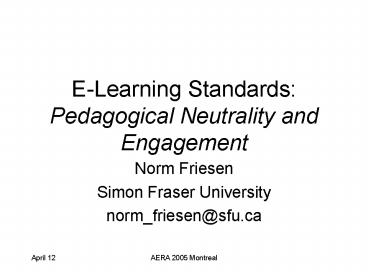ELearning Standards: Pedagogical Neutrality and Engagement - PowerPoint PPT Presentation
1 / 17
Title:
ELearning Standards: Pedagogical Neutrality and Engagement
Description:
A well defined scope is able to 'black-box' related complexity ... Pandora's Hope: Essays on the Reality of Science Studies. Harvard U.P. Friesen, N. (2005) ... – PowerPoint PPT presentation
Number of Views:43
Avg rating:3.0/5.0
Title: ELearning Standards: Pedagogical Neutrality and Engagement
1
E-Learning StandardsPedagogical Neutrality and
Engagement
- Norm Friesen
- Simon Fraser University
- norm_friesen_at_sfu.ca
2
E-Learning Standards Examples
- Learning Object Metadata exchangable database
records for digital learning teaching resources - IMS Learning Design a framework that supports
pedagogical diversity and innovation, while
promoting the exchange and interoperability of
e-learning materials.
3
Rationale for Standardization
- Standards are required for E-Learning to mature
as an industry - Standards as instruments of reduction (Slaton
Abbate, 2001) --reducing - Costs
- Incompatibilities
- Complexity
- Achieve for elearning what the Internet has
accomplished for networking
4
Neutrality
- Definition of Neutrality not decided or
pronounced as to characteristics - Standards are to be neutral regarding
- Culture
- Media used
- Instruction
- Pedagogies
- Agnosticism not knowing about something
- Neutral not caring, but working across pedagogies
5
Learning Object Metadata LOM
- 77 data elements or fields
- Applied localized through the use of
application profiles - These simplify and coordinate implementation by
- Reducing the number of elements to be used (to a
core set) - Documenting their use
6
CanCore Guidelines for Element Use
- Used by dozens of projects and collections in
Canada and globally - Since 2001, surveying and synthesizing best
practices internationally - General LOM implementation http//jtc1sc36.org/do
c/36N0871.pdf - Terms used for one element learning resource
type http//www.cancore.ca/en/guidelines.html
7
International LOM Survey
- 2003 Survey of application profiles gt12 from
different domains and jurisdictions included - How use is directed
- 2004 Survey of gt2000 LOM records from 5
different collections nations - How use occurs
8
(No Transcript)
9
Terms Provided in LOM Standard
- simulation
- questionnaire
- diagram
- figure
- graph
- index
- slide
- table
- exam
- experiment
- problem statement
- self-assessment
- lecture
10
Terms in Application Profiles
- Heal medicine
- Multimedia/Item, Case, Quiz/Question
- ILumina undergraduate science
- Lab Exercise, Assessment, Project, Dataset
- CLEO commercial/training
- Attractor Attracts the learner's attention.
Typically has little or no instructional intent.
11
Pedagogy An Unstructured Field Allert, et al 2001
- Besides different subject matter.
- Teaching and Learning can be
- Social formation, reproduction, construction
- Collaborative
- Discursive
- Cognitive
- Situated
- embodied, distributed, evolutionary,
problem-based, formation, reproduction
12
Complexity and Neutrality in Standards
- Domains or problem spaces is complex and
unbounded - Complexity and ambiguous boundaries are addressed
through scoping - A well defined scope is able to black-box
related complexity - a well-developed standard can itself become a
black box from the perspective of related
complexity
13
Unbounded Complexity
- Bruno Latour when something is black-boxed, it
becomes naturalized accepted without being known
in its complexity - But there are forms of complexity that are
unbounded - Interpretive and associative processes
- Forms of labour, especially interdisciplinary and
non-specialized
14
From the perspective of unbounded activities
- standards can be understood as "instruments that
encode and order labor relations" (Slaton
Abbate, 2001) --whether this labor is physical or
intellectual in character - "the adoption of standards may simplify some
aspects of a system while creating a demand for
more skilled labor elsewhere" (Slaton Abbate,
2001).
15
Pedagogical Utility Pedagogical Engagement
- IMS Question Test Interoperability "The
specification has been produced to allow the
interoperability of content within assessment
systems" - ISO Collaborative Communication Data Model for
the interchange of communicative and related
information generated through the set-up and use
of text-based, synchronous (chat) and
a-synchronous (discussion) communication
technologies.
16
References (1/2)
- Friesen, N. (2004). Three Objections to Learning
Objects. Online Education Using Learning Objects.
In McGreal, R. (ed.) London Routledge. Pp.
59-70. Draft available at http//www.learningspac
es.org/n/papers/objections.html - Slaton, A. Abbate, J. (2001) The Hidden Lives
of Standards Technical Prescriptions and the
Transformation of Work in America. In
Technologies of Power. Allen, M.T. Hecht, G.
(eds), Cambridge, MA MIT Press.
17
References (2/2)
- IMS Learning Design http//www.imsglobal.org/learn
ingdesign/index.html - CanCore http//www.cancore.ca
- Latour, B. (1999). Pandoras Hope Essays on the
Reality of Science Studies. Harvard U.P. - Friesen, N. (2005). Metadata for Synchronous and
Asynchronous Collaborative Learning Environments
http//collab-tech.jtc1sc36.org/doc/SC36_WG2_N0082
.pdf































